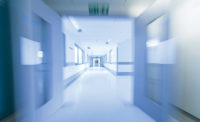Emergency generators are required in many applications where facility operations are to continue to perform even upon a failure of the electric grid. The best resources for quantifying the emergency generation classifications, capacities, installation, maintenance, and operational testing requirements are the building codes and federal regulations. These codes include NFPA, IBC, NEC, and in institutional occupancies like hospitals, the federal regulations headed by the Center for Medicare and Medicaid Services, CMS.
The driving code is the International Building Code (IBC). The IBC identifies the systems that are required to be served with a backup power source. Backup power is divided into two categories: emergency and standby.
Emergency
• Voice communication
• Exit signs
• Egress illumination
• Doors on I-3
• Elevator car lighting
• Fire detection and alarm
• Fire pumps
Standby
• Smoke control
• Egress elevators/platforms
• Sliding doors
• Inflation for membrane structures
• Power & lighting for fire command
In general, all these loads require two hours of operation after a power outage, except fire pumps, which require 8 hours. Hospital and other institutional occupancies, like prisons, are the exception where these loads shall be operational for 96 hours upon failure of the electric grid.
Natural Gas as the fuel source
The question comes up about whether the generators are required to have on-site fuel, which typically is diesel, or whether natural gas is an approved fuel for the emergency generators.
There has been a misunderstanding among code enforcing jurisdictions that the fuel source for emergency generators must be on-site storage of sufficient quantity to serve these loads for the specified duration. This misunderstanding may have come about from a pushback from the CMS where natural gas generators were being used and the CMS stated the need to provide on-site fuel, or, the site must provide a “Letter of Reliability” from the natural gas provider.
As an aside, the IBC code was a major shift from the UBC codes. There was a mantra at the development of the IBC that goes “Sprinkler it and forget it.” The IBC codes expanded the fire sprinkler requirements while significantly reducing the smoke control requirements. For this reason, some jurisdictions will always require the fire pumps to be diesel pumps with their own on-site storage of diesel in the belly tank for the eight-hour duration.
To underscore the fact that natural gas is an approved fuel, all other codes (including NFPA and the NEC) specifically allow for natural gas generators where there is a “low probability of simultaneous failure of both the grid and natural gas.”
More specifically, NFPA 99.6.4.1.1.7 states “The generating equipment used shall be either reserved exclusively for such service or normally used for other purposes of peak demand control, internal voltage control, load relief for the external utility, or cogeneration.” (CHP is synonymous and is a rebranding of what the older generation of engineers calls cogeneration.)
NFPA 110.5.1, 5.1.1, bullet #3 specifically states “Natural or synthetic gas” as a fuel source shall be permitted to be used for the emergency power supply (EPS).
The exception under both NEC Articles 700 & 701 Emergency and Standby Fuel state, “where acceptable to the authority having jurisdiction, the use of other than on-site fuels shall be permitted where there is a low probability of a simultaneous failure of both the off-site fuel delivery system and power from the outside electrical utility company.”
Hospitals are the most regulated of the commercial building sectors. The organization responsible for overseeing these regulations is the Center for Medicare and Medicaid Services (CMS). About 30 years ago, they implemented a major change to emergency generators for hospitals stating the need to provide on-site fuel, or, the site must provide a “Letter of Reliability” from the natural gas provider. Many ran with the on-site fuel requirement. Then, in 2009, they released a power point presentation (http://goo.gl/UhYtTn). In this presentation, they explicitly state that they “never intended to not allow natural gas as a fuel source for backup generators.” They do, however, require a letter from the natural gas provider addressing the following five points.
1. A statement of reasonable reliability of the natural gas delivery.
2. A brief description that supports the statement regarding the reliability.
3. A statement that there is a low probability of interruption of the natural gas.
4. A brief description that supports the statement regarding the low probability of interruption.
5. The signature of technical personnel from the natural gas vendor.
The CMS actually has a sample letter with options from which to select for responding to each of the items.
Why would the CMS make a specific presentation to address and allow natural gas fuel for emergency power? From the presentation link previously mentioned the CMS recognizes many benefits of CHP, including the following.
• CHP provides continuous benefits to host facilities rather than just during emergencies.
• CHP can result in daily operating cost savings.
• CHP offsets capital costs associated with investments in traditional backup power.
• Already in operation in an event. (Author comment: Very important)
• Provides standby electrical as well as emergency heating requirements.
Furthermore, since CHP significantly reduces pollution, CHP contributes to a healthier climate. And, since the CMS is all about health, reducing pollution is a priority.
Natural gas generator reduces pollution
A natural gas generator that is part of normal building operations, such as we have with CHP, reduces pollution. Traditional facility operations purchase electricity from the grid, and serve the thermal loads with natural gas, fuel oil, propane, electricity, etc. When we purchase electricity from the grid, we are using an energy source that emits about twice the pollution of on-site power generation that recovers the heat off the prime mover to serve the thermal loads. In Figure 1, we see that electricity from the grid emits more than two times1 the emissions of natural gas.
When the power utility generates electricity, about 64% of the energy in to the power generator is wasted in heat rejected to atmosphere. CHP allows us to use this wasted heat for free. CHP meet the same power and thermal loads so there is no compromise in comfort, while using a fraction of the overall fuel, thereby reducing pollution in our atmosphere.
How reliable is natural gas?
From a presentation (http://bit.ly/1LRF4Gr) developed by the Alliance for Industrial Efficiency, Business Council for Sustainable Energy, American Gas Association, and ENER-G Rudox, we find this slide in Figure 2 demonstrating that the investment in natural gas infrastructure in the United States has almost doubled in a six-year period.
This investment went toward many upgrades to the natural gas infrastructure after a few national disasters, such as the Northeast Blackout in 2003, Hurricane Katrina, Super Storm Sandy, etc., where huge regions of our country were left without power or an ability to get fuel delivered for many days and weeks.
Natural gas is an underground fuel source that is very dependable. Some natural gas system improvements resulting from the increased funding include:
• Eliminating the brittle black pipe and replacing it with poly-pipe so that it is more flexible and forgiving of tree roots, geological settling, etc.;
• Replacing seismic valves with excess flow valves to isolate a breach;
• Increasing the number of suppliers, so areas can be back-fed should there be a disruption at one location;
• Increased storage sites and capacity.
Emergency generators serve space heating loads, too
There are regulations and codes for the health care sector that require HVAC heating systems in some applications to remain operational in a power outage event. Those thermal loads can be handled seamlessly on the CHP plant. And having those heating systems served by the CHP plant is a consideration for ensuring that the transition to weave CHP into the facility infrastructure is cost-effective.
Major advocates for CHP in health care
Pacific Northwest National Laboratory (PNNL) has put together a document titled “Combined Heat and Power: Enabling Resilient Energy Infrastructure for Critical Facilities,” and can be found at http://www.eere.energy.gov/manufacturing/distributedenergy/pdfs/chp_critical_facilities.pdf. In this document, critical infrastructure (CI) collectively refers to those assets, systems, and networks that, if incapacitated, would have a substantial negative impact on national or regional security, economic operations, or public health and safety.
CHP offers the opportunity to improve CI resiliency, mitigating the impacts of an emergency by keeping critical facilities running without any interruption in electric or thermal service. If the electricity grid is impaired, a specially configured CHP system can continue to operate, ensuring an uninterrupted supply of power and heating or cooling to the host facility.
The Department of Energy, Energy Efficiency and Renewable Energy, EERE, advocates CHP for healthcare (https://goo.gl/8cD9Ir). Another document from EERE (http://goo.gl/I60rHl) highlights the financial advantages, the improved reliability of emergency power, the environmental benefits, the need to consider incentives, and, the importance of proper prime mover type.
Hospitals are ideal candidates for CHP systems. Because hospitals function 365 days a year, 24/7, they require around-the-clock energy. Combined systems enable hospitals to reduce energy costs, improve environmental performance, and increase energy reliability. Resources saved are often redirected to improve patient care.
The Whole Building Design Guide, WBDG, in collaboration with Oak Ridge National Laboratory, USDOE, CHP-Technical Advisory Panel, and others developed a CHP resource guide for hospitals available at https://goo.gl/WW7skL.
The primary objective of this guidebook is to provide a reference document of basic information for hospital managers when considering the application of CHP in the healthcare industry, specifically in hospitals. Hospital administrators are faced with rising and uncertain energy costs, the requirement for higher energy reliability, increasing environmental demands, and shrinking facility budgets. The need exists to constantly evaluate realistic alternatives to today’s conventional approaches to meeting energy demands.
The Environmental Protection Agency issued a Guide to Using Combined Heat and Power for Enhancing Reliability and Resiliency in Buildings (https://goo.gl/pMmGb7).
During and after Hurricane Sandy, CHP enabled a number of critical infrastructure and other facilities to continue their operations when the electric grid went down. Time and again, CHP has proved its value as an alternative source of power and thermal energy (heating and cooling) during emergencies, and demonstrated how it can be a sound choice in making energy infrastructure more resilient in the face of extreme weather events.
CMS (again, the folks who regulate the most-regulated facilities, hospitals) provided a presentation on Natural Gas Emergency Generators (http://goo.gl/AXAWKk). The third bullet on slide 27 and Question #1 on slide 34 directly respond to this issue. ROV never required the conversion away from natural gas or the addition of on-site fuel to a natural gas generator.






